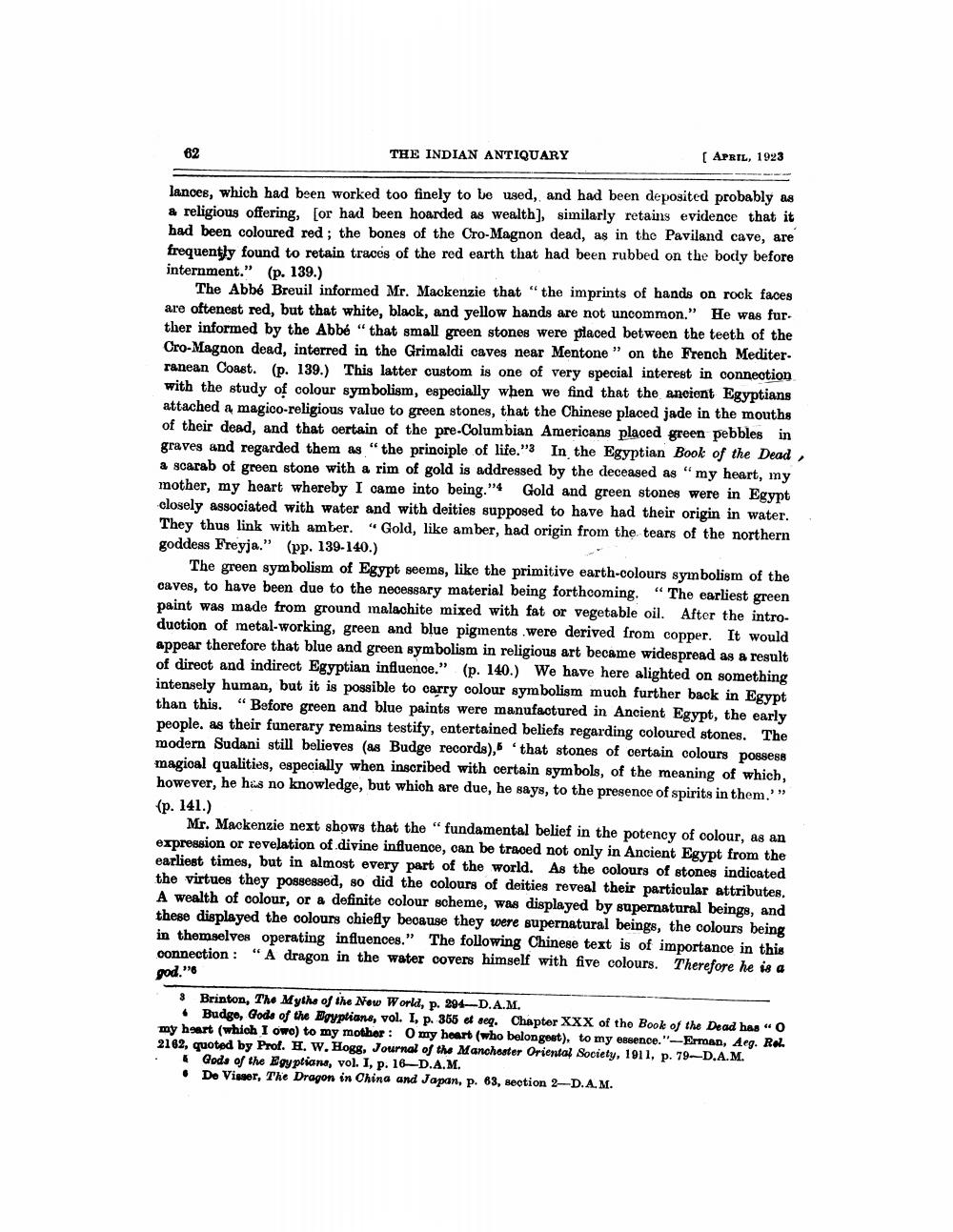________________
62
THE INDIAN ANTIQUARY
( APRIL, 1923
lances, which had been worked too finely to be used, and had been deposited probably as & religious offering, [or had been hoarded as wealth), similarly retains evidence that it had been coloured red; the bones of the Cro-Magnon dead, as in the Paviland cave, are frequently found to retain traces of the red earth that had been rubbed on the body before internment." (p. 139.)
The Abbé Breuil informed Mr. Mackenzie that "the imprints of hands on rook faces are oftenest red, but that white, black, and yellow hands are not uncommon." He was fur. ther informed by the Abbé " that small green stones were placed between the teeth of the Cro-Magnon dead, interred in the Grimaldi caves near Mentone" on the French Mediterranean Coast. (p. 139.) This latter custom is one of very special interest in connection with the study of colour symbolism, especially when we find that the ancient Egyptians attached a magico-religious value to green stones, that the Chinese placed jade in the mouths of their dead, and that certain of the pre-Columbian Americans placed green pebbles in graves and regarded them as "the principle of life.” In the Egyptian Book of the Dead a scarab of green stone with a rim of gold is addressed by the deceased as "my heart, my mother, my heart whereby I came into being."4 Gold and green stones were in Egypt closely associated with water and with deities supposed to have had their origin in water. They thus link with amber. "Gold, like amber, had origin from the tears of the northern goddess Freyja." (pp. 139-140.)
The green symbolism of Egypt seems like the primitive earth-colours symbolism of the caves, to have been due to the necessary material being forthcoming. “The earliest green paint was made from ground malachite mixed with fat or vegetable oil. After the introduction of metal-working, green and blue pigments were derived from copper. It would appear therefore that blue and green symbolism in religious art became widespread as a result of direct and indirect Egyptian influence." (p. 140.) We have here alighted on something intensely human, but it is possible to carry colour symbolism much further back in Egypt than this. "Before green and blue paints were manufactured in Ancient Egypt, the early people, as their funerary remains testify, entertained beliefs regarding coloured stones. The modern Sudani still believes (as Budge records), 'that stones of certain colours possess magical qualities, especially when inscribed with certain symbols, of the meaning of which, however, he has no knowledge, but which are due, he says, to the presence of spirits in them.” (p. 141.)
Mr. Mackenzie next shows that the "fundamental belief in the potency of colour, as an expression or revelation of divine influence, can be traced not only in Ancient Egypt from the earliest times, but in almost every part of the world. As the colours of stones indicated the virtues they possessed, so did the colours of deities reveal their particular attributes. A wealth of colour, or a definite colour scheme, was displayed by supernatural beings, and these displayed the colours chiefly because they were supernatural beings, the colours being in themselves operating influences." The following Chinese text is of importance in this connection: "A dragon in the water covers himself with five colours. Therefore he is a god."
8 Brinton, The Myths of the New World, p. 294-D.A.M.
• Budgo, Gode of the Egyptians, vol. I, p. 365 et seq. Chapter XXX of the Book of the Dead has 0 my heart (which I owo) to my mother: O my heart (who belongest), to my essence."--Erman, Aeg. R. 2162, quoted by Prof. H. W. Hogg, Journal of the Manchester Oriental Society, 1911, p. 79-D.A.M. • Gods of the Egyptiane, vol. I, p. 16-D.A.M.
• De Visser, The Dragon in China and Japan, p. 63, section 2-D.A.M.




